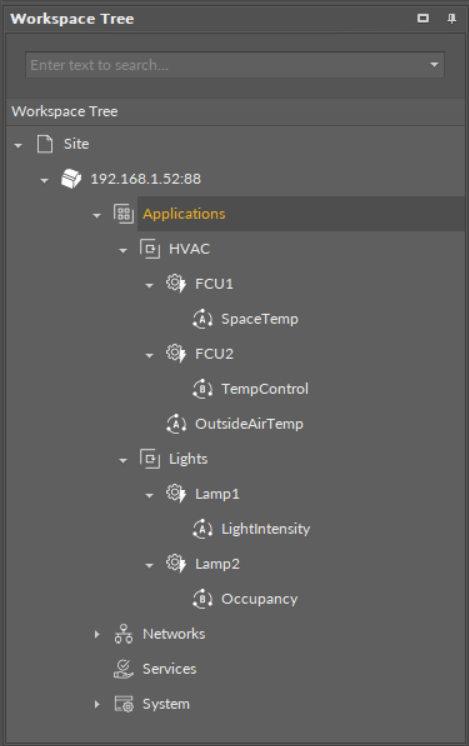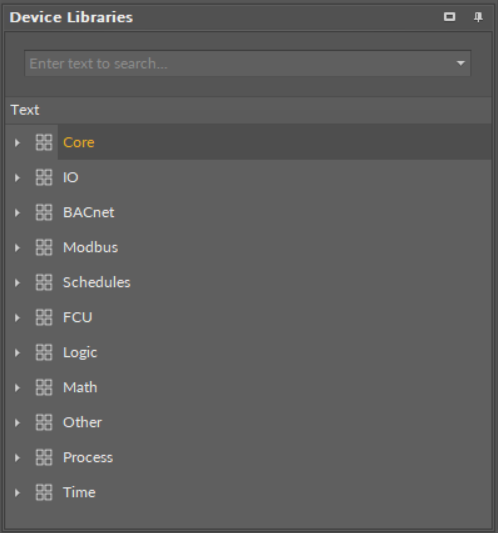The first element in the Device structure is the Applications container. It is a non-removable element, which offers a space to create user applications.
The Applications container allows to add multiple Application components for building independent user applications, which are cycle-driven and may work simultaneously.
The user may define the application purpose (heating, lighting, etc.) and a cycle time of algorithms operation (cycles may differ between applications).
Tip
Multithreaded applications allow to differentiate cycles of applications (scan period) in order to adjust them according to a purpose of an application.
For example, a HVAC application may be set to 1000 ms scan period, and a Lights application to 200 ms scan period, as changes to lights operation have to be implemented immediately. Setting such scan periods would mean that the Lights application would be executed 5 times for each HVAC application cycle.

The user may create as many applications as needed—as long as the overall number of Data Points used within user applications does not exceed the device license.
Note: For top performance, it is recommended to use up to three different applications.
Good Practice Tip
In future developments, the RAC18-IP controller will have a Haystack functionality implemented in its firmware, which calls for some good practice mechanisms that can be introduced now, with the current functionalities.
The Haystack functionality will offer multiple advantages of using tags–it will help identify parts of equipment controlled by the application and used Data Points, filter data by equipment, sensor, or value, any many more.
In order to facilitate a future use of the full Haystack functionality, the Equipment component has been included in the Core library. It is therefore recommended to use the following structure when creating applications:
-
Applications container
-
Application component
-
Equipment component
-
Data Point(s)
-
other components
-
-
Equipment component
-
Data Point(s)
-
other components
-
-
-
Such structure will be fully recognized in the Haystack functionality and will require minimum effort to use its full potential once updated.

Difference Between Equipment and Folder Components
The Equipment component with Haystack functionality will allow to identify the types and other characteristics of controlled devices by tags, which will be a main difference between the Equipment and Folder components–the Folder component is merely an organizing component; in the future, it will not carry any Haystack tags functionalities. It is therefore very important to use the Equipment components in the applications structure.
Also refer to: Equipment Manager
Remember - Great Licensing Scheme
The Applications container includes the only elements subject to license in the nano EDGE ENGINE devices.
The license for the new generation of iSMA CONTROLLI controllers driven by the nano EDGE ENGINE is constructed against the number of Data Points: each device based on the nano EDGE ENGINE is granted a specified number of license points (Data Points in this case), which can be used within applications. Therefore, the licensing system is only of quantitative, not functional, character–only the real number of Data Points in applications is taken into account, regardless of how many communication protocols are used to expose them, or how many network points are controlled. With the nano EDGE ENGINE-generation devices it is possible to create as big an application (or applications) as the number of licensed Data Points. No elements in the Networks, Services, or System containers are subject to license limitations, other than Data Points in the Applications container.
Note: In order to check the number of license points, please refer to the License in the device.
Applications Libraries
The nano EDGE ENGINE Applications libraries provide sets of components (service and basic) that allow to create HVAC applications. Libraries are grouped by specific functionalities, for example, by families of algorithms, etc. This section provides information about the nano EDGE ENGINE libraries designed for the Applications container, their functionalities and elements.
-
Core library;
-
FCU library;
-
Logic library;
-
Math library;
-
Other library;
-
Process library;
-
Time library;
-
Schedules library.

nano Edge Engine libraries
